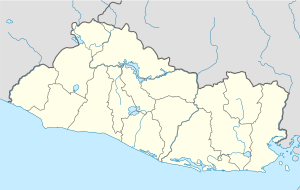
Chalatenango is a department of El Salvador located in the northwest of the country. The department's capital city is the city of Chalatenango, which shares the same name as the department. Chalatenango covers a land area of 779 sq mi (2,017 km2) and contains over 192,000 inhabitants. Chalatenango's maximum elevation, located at Cerro El Pital, is 8,960 feet (2,730 m).

Ahuachapán is a city, municipality, and the capital of the Ahuachapán Department in western El Salvador. The municipality, including the city, covers an area of 244.84 km2 and as of 2007 has a population of 110,511 people. Situated near the Guatemalan border, it is the westernmost city in the country and is the center of an agricultural region producing primarily coffee.

Concepción Batres is a municipality in the Usulután department of El Salvador.It is bordered to the north by El Tránsito and Ereguayquín; to the east by El Tránsito and Jucuarán; to the south by Usulután and to the west by Ereguayquín and Usulután.

Santa Rita is a district in the Chalatenango department of El Salvador and is one of the largest municipalities of Chalatenango. It has a shoreline on Lake Suchitlán and is bordered by the municipalities of Comalapa, Dulce Nombre de María, Concepción Quetzaltepeque, El Paraíso, and San Rafael.
Agua Caliente, Aguas Calientes or Aguascalientes may refer to:

Dulce Nombre de María is a town and municipality in the Chalatenango Department of El Salvador. It is located 72 kilometers (45 mi) from San Salvador, the capital of El Salvador.

La Palma is a municipality in the Chalatenango department of El Salvador. The municipality, located in a mountainous area of the country, covers an area of 135.60 km2 and as of 2006 had an approximate population of 24,000.
Las Vueltas is a municipality in the Chalatenango Department in the north of El Salvador. The municipality is bordered to the north by Ojos de Agua, to the east by Las Flores, to the south by Chalatenango, and to the northeast by Concepción Quezaltepeque. The territory covers 36.83 km2 and the population was, as of 2005, of 2,101 inhabitants. For its administration, the municipality is divided into six cantones and 35 caseríos.

Suchitoto is a municipality in the Department of Cuscatlán, El Salvador that has seen continuous human habitation long before Spanish colonization. Within its municipal territory, Suchitoto holds the site of the original founding of the Villa of San Salvador in 1528 that existed for a short time before the site was abandoned. In more recent times, the municipality has prospered even after the severe effects of civil war in El Salvador that lasted between 1980 - 1992 and saw the population of Suchitoto decrease from 34,101 people in 1971 to 13,850 by 1992. It has become an important tourist destination partly due to its well conserved colonial architecture and cobblestone roads that provide a sense of Spanish colonial living. This rise in tourism has attracted service sector businesses to open up in the small city including hostels, restaurants, and picturesque cafes. As a result of tourism, many arts and cultural spaces have opened up in Suchitoto that are also providing positive alternative opportunities for youth in the community. According to the 2007 Official Census, the small city has a population of 24,786 people with 7,654 people living in the urban area and 17,132 people living in the rural communities.

Colonel Joaquín de San Martín y Ulloa was a Salvadoran military officer and politician who was twice chief of state of the State of El Salvador, within the Federal Republic of Central America.

San Francisco de Sales, commonly known as San Francisco, is a municipality and town of Colombia in the department of Cundinamarca.

Chalatenango is a municipality located in the Department of Chalatenango, in the north of El Salvador.

San Jose Ojos de Agua is a municipality is located in the department of Chalatenango in the North of El Salvador
El Carrizal is a municipality located in the department of Chalatenango in the North of El Salvador.
La Laguna is a municipality in the Chalatenango department of El Salvador.
Zapotlán del Rey is a town and municipality in Jalisco in west-central Mexico. The municipality covers an area of 400 km2.

The Cerrón Grande Hydroelectric Dam spans the Lempa River 78 km (48 mi) north of San Salvador in the municipalities of Potonico, (Chalatenango) and Jutiapa (Cabañas) in El Salvador.
Cimarron Hydroelectric Power Project a hydroelectric power plant in El Salvador, that was to start construction in 2010. The plant would have been be located in the upper basin of the Lempa River, upstream of the Cerrón Grande Hydroelectric Dam. The proposed location of the dam was between the town of Agua Caliente on the left shore and Metapán, Santa Ana, on the right shore. A tunnel would divert water from the Lempa River to a powerhouse and substation to be built near Agua Caliente. With an estimated capacity of 261 megawatts, the project would have increased El Salvador's total generation capacity by almost 25%.

Canton El Tablón belonged to the municipality of Suchitoto, Cuscatlán, El Salvador. Canton El Tablón was one of many cantons in the surrounding area that was flooded as a result of the Cerrón Grande Hydroelectric Dam built in El Salvador between 1972 and 1976 that created the artificial Cerrón Grande Reservoir. According to former residents of El Tablón, the area was divided up into four main caseríos: Caserio La Hacienda Vieja, Caserio Los Figueroas, Caserio Valle El Tablón, and Caserio Los Palitos. It is unclear where the name El Tablón originated from, but according to local historians, a village named "El Tablón" existed prior to 1860 that was formed through a municipal ejido. An ejido was commonly owned municipal land granted by the Spanish Crown to governing bodies in the Spanish Empire. These lands were considered vacant or unused land in some cases belonging to existing indigenous communities.













